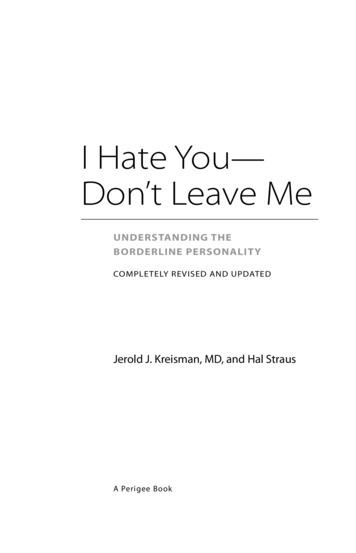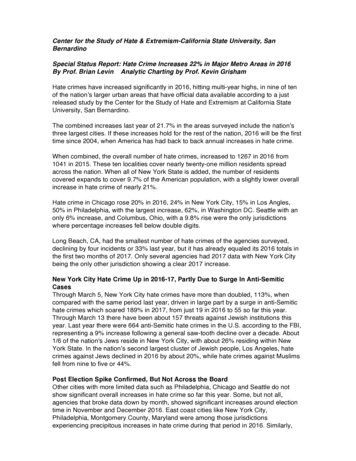
Transcription
I Hate You—Don’t Leave MeUNDERSTANDING THEBORDERLINE PERSONALITYCOMPLETELY REVISED AND UPDATEDJerold J. Kreisman, MD, and Hal StrausA Perigee Book
“I Hate You—Don’t Leave Me was the first book to introduce BPDto the public. We are all indebted to Dr. Kreisman for his pioneeringefforts to raise awareness of this painful mental disorder. As researchand treatment have advanced so much since then, we welcome thisneeded update to what is now a classic text.”—Valerie Porr, MA, president and founder of Treatment and ResearchAdvancements National Association for Personality Disorder, andauthor of Overcoming BPD“Dr. Kreisman and Hal Straus have thoroughly revised their twenty year classic to include the latest advances in therapies and medicationswhile retaining the rich, easy-to-read style of the first edition. Real-lifecase studies and the extensive list of references illuminate our under standing of borderline personality not only for the general public but forprofessionals as well. This book belongs on the bookshelf of patients,their friends and family, and for all those who help in their healing.”—Randi Kreger, author of Stop Walking on Eggshells andThe Essential Family Guide to Borderline Personality Disorder
I Hate You—Don’t Leave MeUNDERSTANDING THEBORDERLINE PERSONALITYCOMPLETELY REVISED AND UPDATEDJerold J. Kreisman, MD, and Hal StrausA Perigee Book
A PERIGEE BOOKPublished by the Penguin GroupPenguin Group (USA) Inc.375 Hudson Street, New York, New York 10014, USAPenguin Group (Canada), 90 Eglinton Avenue East, Suite 700, Toronto, Ontario M4P 2Y3, Canada(a division of Pearson Penguin Canada Inc.) Penguin Books Ltd., 80 Strand, London WC2R 0RL,England Penguin Group Ireland, 25 St. Stephen’s Green, Dublin 2, Ireland (a division of PenguinBooks Ltd.) Penguin Group (Australia), 250 Camberwell Road, Camberwell, Victoria 3124,Australia (a division of Pearson Australia Group Pty. Ltd.) Penguin Books India Pvt. Ltd.,11 Community Centre, Panchsheel Park, New Delhi—110 017, India Penguin Group (NZ), 67 ApolloDrive, Rosedale, North Shore 0632, New Zealand (a division of Pearson New Zealand Ltd.) PenguinBooks (South Africa) (Pty.) Ltd., 24 Sturdee Avenue, Rosebank, Johannesburg 2196, South AfricaPenguin Books Ltd., Registered Offices: 80 Strand, London WC2R 0RL, EnglandWhile the author has made every effort to provide accurate telephone numbers and Internet addressesat the time of publication, neither the publisher nor the author assumes any responsibility for errorsor for changes that occur after publication. Further, the publisher does not have any control over anddoes not assume any responsibility for author or third-party websites or their content.Copyright 2010 by Jerold J. Kreisman, MD, and Hal StrausText design by Tiffany EstreicherAll rights reserved.No part of this book may be reproduced, scanned, or distributed in any printed or electronic form with out permission. Please do not participate in or encourage piracy of copyrighted materials in violationof the author’s rights. Purchase only authorized editions.PERIGEE is a registered trademark of Penguin Group (USA) Inc.The “P” design is a trademark belonging to Penguin Group (USA) Inc.Library of Congress Cataloging-in-Publication DataKreisman, Jerold J. (Jerold Jay)I hate you—don’t leave me : understanding the borderline personality / Jerold J. Kreismanand Hal Straus.— Rev. and updated.p. cm.“A Perigee book.”Includes bibliographical references and index.ISBN 1-101-44168-21. Borderline personality disorder. I. Straus, Hal. II. Title.RC569.5.B67K74 2010616.85'852—dc222010029714Disclaimer: The information in this book is true and correct to the best of our knowledge. The book isintended only as a general guide to a specific type of personality disorder and is not intended as a replace ment for sound medical advice or services from the individual reader’s personal physician. The stories thatbegin many chapters, and other case history material throughout the book, have been developed fromcomposites of several people and do not represent any actual person, living or dead. Any resemblance toany actual person is unintentional and purely coincidental. All recommendations herein are made withoutguarantees by the authors or publisher. The authors and the publisher disclaim all liability, direct or con sequential, in connection with the use of any information or suggestion in this book.Most Perigee books are available at special quantity discounts for bulk purchases for sales promotions,premiums, fund-raising, or educational use. Special books, or book excerpts, can also be created tofit specific needs. For details, write: Special Markets, Penguin Group (USA) Inc., 375 Hudson Street,New York, New York 10014.
As all things,still,for Doody
CO N T E N T SAcknowledgmentsPrefaceixxiNote to Reader xv1.The World of the Borderline 12.Chaos and Emptiness3.Roots of the Borderline Syndrome4.The Borderline Society 745.Communicating with the Borderline6.Coping with the Borderline 1237.Seeking Therapy8.Specific Psychotherapeutic Approaches9.Medications: The Science and the Promise10.2254101142176192Understanding and Healing 204Appendix A. DSM-IV-TR Classifications 223Appendix B. Evolution of the Borderline SyndromeResourcesNotes 247Index261241229
AC K N O W L E D G M E N T SThe efforts necessary to complete this new edition required bothgreat assistance and forbearance. Assistance initiated with BruceSeymour of Goodeye Photoshare (goodeye-photoshare.com), whodonated much time and effort with technical issues producingthe manuscript. Another dear friend, Eugene Horwitz, massagedfrustrating computer conundrums. My secretaries, Jennifer Jacoband Cindy Fridley, helped gather articles and books incorporatedinto the work. Lynne Klippel, energetic librarian at DePaul HealthCenter, St. Louis, tracked down helpful references.Great forbearance was demonstrated by my partners and staffof Allied Behavioral Consultants of St. Louis, who allowed me thefreedom to pursue this task. My wife, Judy, and children, Jenny,Adam, Brett, and Alicia, and the little ones, Owen and Audreyand a Player to Be Named Later, courageously consented to miss afew ball games, several plays, and a lot of movies while I indulgedsunny afternoons researching and writing.
xACKNOWLEDGMENTSWe wish to thank our agent, Danielle Egan-Miller, at Browne &Miller Literary Associates, and John Duff and Jeanette Shaw, ourpublisher and editor, respectively, at Perigee/Penguin. All playedimportant roles in shaping the contents of this book.
P R E FAC EWhen the first edition of I Hate You—Don’t Leave Me was pub lished in 1989, very little information was available to the generalpublic on the subject of Borderline Personality Disorder. Researchinto the causes of, and treatments for, BPD was in its infancy. Thefew articles that had appeared in consumer magazines vaguelyoutlined the disorder as it began to infiltrate the “American con sciousness.” There were virtually no books on BPD for the patientor the patient’s close family and friends. The response to our book,both in this country and abroad with foreign translations, has beenmost gratifying. My intention to produce a work accessible to thegeneral public, yet functional for professionals with useful refer ences, seems to have been fulfi lled.To say that a lot has happened in this area over twenty years isobviously a vast understatement. Several other books on BPD havebeen published, including our own Sometimes I Act Crazy (2004),describing the experience of this illness from the perspectives of
xiiPREFACEafflicted individuals, family members, and treating professionals.Greater understanding of the etiology, biological, genetic, psy chological, and social implications and treatment approaches hasadded exponentially to our knowledge. So the challenge of writingthis second edition was to highlight and explain the most impor tant advances, present useful, referenced information for the pro fessional, and yet manage the length of the book so it can continueto serve as an engaging introduction to BPD for the lay reader. Toachieve this balance, a few chapters needed only updating, but oth ers, especially those on the possible biological and genetic roots ofthe syndrome, were extensively rewritten in order to incorporatethe latest scientific research. Additionally, specific psychothera peutic approaches and drug treatments have evolved to such anextent that it was necessary to include entirely new chapters onthese topics. The book’s reliance on real-life case stories, to givethe reader insight into what life is like for—and with—a border line, continues in this edition, though the backdrop of these storieswas altered to reflect the changes in American society from onecentury to the next. Perhaps the biggest change from the first edi tion is one of overall tone: whereas the prognosis for patients wasunderstandably bleak two decades ago, it is now (based on numer ous longitudinal studies) much more positive.And yet, despite these advancements, it is disappointing toreview the preface to the first edition and recognize that misun derstanding and especially stigma still run rampant. BPD remainsan illness that continues to confuse the general public and terrifymany professionals. As recently as 2009, a Time magazine articlereported that “[b]orderlines are the patients psychologists fearmost” and “[m]any therapists have no idea how to treat [them].”As Marsha Linehan, a leading expert on BPD, noted, “Borderlineindividuals are the psychological equivalent of third-degree burnpatients. They simply have, so to speak, no emotional skin. Even
PREFACExiiithe slightest touch or movement can create immense suffering.”1Nevertheless, development of specific therapies and drugs targetedat the disorder (see chapters 8 and 9) has provided some relief frompatients’ burdens, and perhaps more important, public aware ness of BPD has grown significantly from what it was in 1989. Asyou will see in the Resources section at the end of this book, thenumber of books, websites, and support groups has proliferated.Perhaps the clearest sign of public acknowledgment occurred in2008, when Congress designated May as “Borderline PersonalityDisorder Awareness Month.”Still, huge challenges remain, especially fi nancial. Reimburse ment for cognitive medical services is shamefully, disproportionatelysmall. For one hour of psychotherapy, most insurance companies(as well as Medicare) pay less than 8 percent of the reimbursementrate allocated for a minor outpatient surgical procedure, such as afifteen-minute cataract operation. Research for BPD has also beeninadequate. The lifetime prevalence rate of BPD in the populationis twice that of both schizophrenia and bipolar disorder combined,and yet the National Institute of Mental Health (NIMH) devotesless than 2 percent of the monies apportioned to the studies of thoseillnesses to research on BPD.2 As our country tries to control healthcare costs, we must understand that investment in research willeventually improve the health of this country and thus lower long term health care costs. But we will need to reevaluate the prioritieswe place on limited resources, and recognize that rationing mayimpact not only delivery of care but also advancements toward acure.Many in the public and professional realm have kindly referredto the original publication of this book as the “classic” in the field.After two decades, it has been a labor of love to revisit our workand update the voluminous data accumulated during this interval.It is my hope that by refreshing and refurbishing our original effort
xivPREFACEwe can play a small part in rectifying the misunderstandings anderasing the stigma associated with BPD and retain the honor ofbeing referenced widely as a primary resource.—Jerold J. Kreisman, MD
N OT E TO R E A D E RMost books on health follow a number of style guidelines (forexample, Publication Manual of the American Psychological Asso ciation) that are designed to minimize the stigma of disease and toemploy politically correct gender designations. Specifically, refer ring to an individual by an illness (for example, “the schizophrenicusually has . . .”) is discouraged; instead, reference is made to anindividual who expresses symptoms of the disease (for example,“the patient diagnosed as a schizophrenic usually has . . .”). Also,gender-specific pronouns are avoided; instead, sentences are struc tured in a passive syntax or use “he/she, him/her” constructions.Though laudable in some respects, these recommendationscomplicate the communication of information. Although we abhorthe implied disrespect and dehumanization of referring to peopleby their medical conditions (“Check on the gallbladder in the nextroom!”), we have nevertheless chosen, for the sake of clarity andefficiency, to sometimes refer to individuals by their diagnosis.
xviNOTE TO READERFor example, we use the term “borderline(s)” as a kind of short hand to represent the more precise designation, “human being(s)who exhibit(s) symptoms consistent with the diagnosis Border line Personality Disorder, as defined by the American Psychiat ric Association’s Diagnostic and Statistical Manual of MentalDisorders, Fourth Edition, Text Revision (DSM-IV-TR).” For thesame reason, we alternate pronouns throughout, rather than bur den the reader with the “he/she, him/her” construction. We trustthat the reader will grant us this liberty to streamline the text.
Chapter OneThe World of the BorderlineEverything looked and sounded unreal. Nothing was what it is.That’s what I wanted—to be alone with myself in another worldwhere truth is untrue and life can hide from itself.—From Long Day’s Journey into Night, by Eugene O’NeillDr. White thought it would all be relatively straightforward. Overthe five years he had been treating Jennifer, she had few medicalproblems. Her stomach complaints were probably due to gastritis,he thought, so he treated her with antacids. But when her stomachpains became more intense despite treatment and routine testingproved normal, Dr. White admitted Jennifer to the hospital.After a thorough medical workup, Dr. White inquired aboutstresses Jennifer might be experiencing at work and home. She read ily acknowledged that her job as a personnel manager for a majorcorporation was very pressured, but as she put it, “Many peoplehave pressure jobs.” She also revealed that her home life was morehectic recently: She was trying to cope with her husband’s busy legalpractice while tending to the responsibilities of being a mother. Butshe doubted the connection of these factors to her stomach pains.When Dr. White recommended that Jennifer seek psychiatricconsultation, she initially resisted. It was only after her discomfort
2I HATE YOU—DON’T LEAVE MEturned into stabs of pain that she reluctantly agreed to see the psy chiatrist Dr. Gray.They met a few days later. Jennifer was an attractive blond womanwho appeared younger than her twenty-eight years. She lay in bedin a hospital room that had been transformed from an anonymouscubicle into a personalized lair. A stuffed animal sat next to her inbed and another lay on the nightstand beside several pictures of herhusband and son. Get-well cards were meticulously displayed in aline along the windowsill, flanked by flower arrangements.At first, Jennifer was very formal, answering all of Dr. Gray’squestions with great seriousness. Then she joked about how her jobwas “driving me to see a shrink.” The longer she talked, the saddershe looked. Her voice became less domineering and more childlike.She told him how a job promotion was exacting more demands—new responsibilities that were making her feel insecure. Her five year-old son was starting school, which was proving to be a difficultseparation for both of them. Conflicts with Allan, her husband, wereincreasing. She described rapid mood swings and trouble sleeping.Her appetite had steadily decreased and she was losing weight. Herconcentration, energy, and sex drive had all diminished.Dr. Gray recommended a trial of antidepressant medications,which improved her gastric symptoms and seemed to normalizeher sleeping patterns. In a few days she was ready for dischargeand agreed to continue outpatient therapy.Over the following weeks, Jennifer talked more about herupbringing. Reared in a small town, she was the daughter of aprominent businessman and his socialite wife. Her father, an elderin the local church, demanded perfection from his daughter andher two older brothers, constantly reminding the children that thecommunity was scrutinizing their behavior. Jennifer’s grades, herbehavior, even her thoughts were never quite good enough. Shefeared her father, yet constantly—and unsuccessfully—sought his
THE WORLD OF THE BORDERLINE3approval. Her mother remained passive and detached. Her par ents evaluated her friends, often deeming them unacceptable. As aresult, she had few friends and even fewer dates.Jennifer described her roller-coaster emotions, which seemedto have worsened when she started college. She began drinking forthe first time, sometimes to excess. Without warning, she wouldfeel lonely and depressed and then high with happiness and love.On occasion, she would burst out in rage against her friends—fitsof anger that she had somehow managed to suppress as a child.It was about this time that she also began to appreciate theattention of men, something she had previously always avoided.Though she enjoyed being desired, she always felt she was “fool ing” or tricking them somehow. After she began dating a man, shewould sabotage the relationship by stirring up conflict.She met Allan as he was completing his law studies. He pur sued her relentlessly and refused to be driven away when she triedto back off. He liked to choose her clothes and advise her on howto walk, how to talk, and how to eat nutritiously. He insisted sheaccompany him to the gym where he frequently worked out.“Allan gave me an identity,” she explained. He advised her on howto interact with his society partners and clients, when to be aggressive,when to be demure. She developed a cast of “repertoire players”—characters or roles whom she could call to the stage on cue.They married, at Allan’s insistence, before the end of her junioryear. She quit school and began working as a receptionist, but heremployer recognized her intelligence and promoted her to moreresponsible jobs.At home, however, things began to sour. Allan’s career and hisinterest in bodybuilding caused him to spend more time away fromhome, which Jennifer hated. Sometimes she would start fights justto keep him home a little longer. Frequently, she would provoke himinto hitting her. Afterward she would invite him to make love to her.
4I HATE YOU—DON’T LEAVE MEJennifer had few friends. She devalued women as gossipy anduninteresting. She hoped that Scott’s birth, coming two years afterher marriage, would provide the comfort she lacked. She felt herson would always love her and always be there for her. But thedemands of an infant were overwhelming, and after a while, Jen nifer decided to return to work.Despite frequent praise and successes at work, Jennifer con tinued to feel insecure, that she was “faking it.” She became sex ually involved with a coworker who was almost forty years hersenior.“Usually I’m okay,” she told Dr. Gray. “But there’s another sidethat takes over and controls me. I’m a good mother. But my otherside makes me a whore; it makes me act crazy!”Jennifer continued to deride herself, particularly when alone;during times of solitude, she would feel abandoned, which sheattributed to her own unworthiness. Anxiety would threaten tooverwhelm her unless she found some kind of release. Sometimesshe’d indulge in eating binges, once consuming an entire bowl ofcookie batter. She would spend long hours gazing at pictures of herson and husband, trying to “keep them alive in my brain.”Jennifer’s physical appearance at her therapy sessions fluctu ated dramatically. When coming directly from work, she woulddress in a business suit that exuded maturity and sophistication.But on days off she showed up in short pants and knee socks, withher hair in braids; at these appointments she acted like a little girlwith a high-pitched voice and a more limited vocabulary.Sometimes she would transform right before Dr. Gray’s eyes. Shecould be insightful and intelligent, working collaboratively towardgreater self-understanding, and then become a child, coquettishand seductive, pronouncing herself incapable of functioning in theadult world. She could be charming and ingratiating or manipula tive and hostile. She could storm out of one session, vowing never
THE WORLD OF THE BORDERLINE5to return, and at the next session cower with the fear that Dr. Graywould refuse to see her again.Jennifer felt like a child clad in the armor of an adult. She wasperplexed at the respect she received from other adults; she expectedthem to see through her disguise at any moment, revealing her asan empress with no clothes. She needed someone to love and pro tect her from the world. She desperately sought closeness, but whensomeone came too close, she ran.Jennifer is afflicted with Borderline Personality Disorder (BPD).She is not alone. Recent studies estimate that 18 million or moreAmericans (almost 6 percent of the population) exhibit primarysymptoms of BPD, and many studies suggest this figure is an under estimation.1 Approximately 10 percent of psychiatric outpatientsand 20 percent of inpatients, and between 15 and 25 percent of allpatients seeking psychiatric care, are diagnosed with the disorder.It is one of the most common of all of the personality disorders.2,3,4Yet, despite its prevalence, BPD remains relatively unknown tothe general public. Ask the man on the street about anxiety, depres sion, or alcoholism, and he would probably be able to provide asketchy, if not technically accurate, description of the illness. Askhim to define Borderline Personality Disorder, and he would prob ably give you a blank stare. Ask an experienced mental health clini cian about the disorder, on the other hand, and you will get a muchdifferent response. She will sigh deeply and exclaim that of all thepsychiatric patients, borderlines are the most difficult, the mostdreaded, and the most to be avoided—more than schizophrenics,more than alcoholics, more than any other patient. For more thana decade, BPD has been lurking as a kind of “Third World” ofmental illness—indistinct, massive, and vaguely threatening.BPD has been underrecognized partly because the diagnosis is
6I HATE YOU—DON’T LEAVE MEstill relatively new. For years, “borderline” was used as a catchallcategory for patients who did not fit more established diagnoses.People described as “borderline” seemed more ill than neurotics(who experience severe anxiety secondary to emotional conflict),yet less ill than psychotics (whose detachment from reality makesnormal functioning impossible).The disorder also coexists with, and borders on, other mentalillnesses: depression, anxiety, bipolar (manic-depressive) disorder,schizophrenia, somatization disorder (hypochondriasis), disso ciative identity disorder (multiple personality), attention deficit/hyperactivity disorder (ADHD), post-traumatic stress disorder,alcoholism, drug abuse (including nicotine dependence), eatingdisorders, phobias, obsessive-compulsive disorder, hysteria, socio pathy, and other personality disorders.Though the term borderline was first coined in the 1930s, the con dition was not clearly defined until the 1970s. For years, psychiatristscould not seem to agree on the separate existence of the syndrome, muchless on the specific symptoms necessary for diagnosis. But as more andmore people began to seek therapy for a unique set of life problems,the parameters of the disorder crystallized. In 1980, the diagnosis ofBorderline Personality Disorder was first defined in the American Psy chiatric Association’s third edition of the Diagnostic and StatisticalManual of Mental Disorders (DSM-III), the diagnostic “bible” of thepsychiatric profession. Since then, several revisions of the DSM havebeen produced, the most recent being DSM-IV-TR, published in 2000.Though various schools within psychiatry still quarrel over the exactnature, causes, and treatment of BPD, the disorder is officially rec ognized as a major mental health problem in America today. Indeed,BPD patients consume a greater percentage of mental health servicesthan those with just about any other diagnosis.5,6 Additionally, studiescorroborate that about 90 percent of patients with the BPD diagnosisalso share at least one other major psychiatric diagnosis.7,8
THE WORLD OF THE BORDERLINE7In many ways, the borderline syndrome has been to psychiatrywhat the virus is to general medicine: an inexact term for a vaguebut pernicious illness that is frustrating to treat, difficult to define,and impossible for the doctor to explain adequately to his patient.Demographic BordersWho are the borderline people one meets in everyday life?She is Carol, a friend since grade school. Over a minor slight, sheaccuses you of stabbing her in the back and tells you that you werereally never her friend at all. Weeks or months later, Carol callsback, congenial and blasé, as if nothing had happened between you.He is Bob, a boss in your office. One day, Bob bestows glow ing praise on your efforts in a routine assignment; another day, heberates you for an insignificant error. At times he is reserved and dis tant; other times he is suddenly and uproariously “one of the boys.”She is Arlene, your son’s girlfriend. One week, she is the picture ofpreppy; the next, she is the epitome of punk. She breaks up with yourson one night, only to return hours later, pledging endless devotion.He is Brett, your next-door neighbor. Unable to come to gripswith his collapsing marriage, he denies his wife’s obvious unfaith fulness in one breath, and then takes complete blame for it in thenext. He clings desperately to his family, caroming from guilt andself-loathing to raging attacks on his wife and children who haveso “unfairly” accused him.If the people in these short profiles seem inconsistent, it should notbe surprising—inconsistency is the hallmark of BPD. Unable to toler ate paradox, borderlines are walking paradoxes, human catch-22s.Their inconstancy is a major reason why the mental health professionhas had such difficulty defining a uniform set of criteria for the illness.If these people seem all too familiar, this also should not be
8I HATE YOU—DON’T LEAVE MEsurprising. The chances are good that you have a spouse, relative,close friend, or coworker who is borderline. Perhaps you know a littlebit about BPD or recognize borderline characteristics within yourself.Though it is difficult to get a fi rm grasp on the figures, mentalhealth professionals generally agree that the number of border lines in the general population is growing—and at a rapid pace—though some observers claim that it is the therapists’ awareness ofthe disorder that is growing rather than the number of borderlines.Is borderline personality really a modern-day “plague,” or ismerely the diagnostic label borderline new? In any event, the disor der has provided new insight into the psychological framework ofseveral related conditions. Numerous studies have linked BPD withanorexia, bulimia, ADHD, drug addiction, and teenage suicide—allof which have increased alarmingly over the last decade. Some stud ies have uncovered BPD in almost 50 percent of all patients admittedto a facility for an eating disorder.9 Other studies have found thatover 50 percent of substance abusers also fulfill criteria for BPD.Self-destructive tendencies or suicidal gestures are very commonamong borderlines—indeed, they are one of the syndrome’s definingcriteria. As many as 70 percent of BPD patients attempt suicide. Theincidence of documented death by suicide is about 8 to 10 percentand even higher for borderline adolescents. A history of previoussuicide attempts, a chaotic family life, and a lack of support systemsincrease the likelihood. The risk multiplies even more among bor derline patients who also suffer from depressive or manic-depressive(bipolar) disorders, or from alcoholism or drug abuse.10,11How Doctors Diagnose Psychiatric DiseaseBefore 1980, the previous two editions of the DSM described psy chiatric illnesses in descriptive terms. However, DSM-III defined
THE WORLD OF THE BORDERLINE9psychiatric disorders along structured, categorical paradigms; thatis, several symptoms have been proposed to be suggestive of a par ticular diagnosis, and when a certain number of these criteria aremet, the individual is considered to fulfill the categorical require ments for diagnosis. Interestingly, in the four revisions of DSMsince 1980, only minor adjustments have been made to the defi nitional criteria for BPD. As we shall see shortly, nine criteria areassociated with BPD, and an individual qualifies for the diagnosisif he exhibits five or more of the nine.The categorical paradigm has stimulated controversy amongpsychiatrists, especially regarding the diagnosis of personalitydisorders. Unlike most other psychiatric illnesses, personality dis orders are generally considered to develop in early adulthood andto persist for extended periods. These personality traits tend to beenduring and change only gradually over time. However, the cate gorical system of definitions may result in an unrealistically abruptdiagnostic change. In relation to BPD, a borderline patient whoexhibits five symptoms of BPD theoretically ceases to be consid ered borderline if one symptom changes. Such a precipitous “cure”seems inconsistent with the concept of personality.Some researchers have suggested adjusting the DSM to a dimen sional approach to diagnosis. Such a
Stop Walking on Eggshells. and . The Essential Family Guide to Borderline Personality Disorder . 9780399536212_IHateYou_FM_pi-xvi.indd ii 16/09/10 7:41 AM. 9780399536212_IHateYou_FM_pi-xvi.indd iii 16/09/10 7:41 AM










